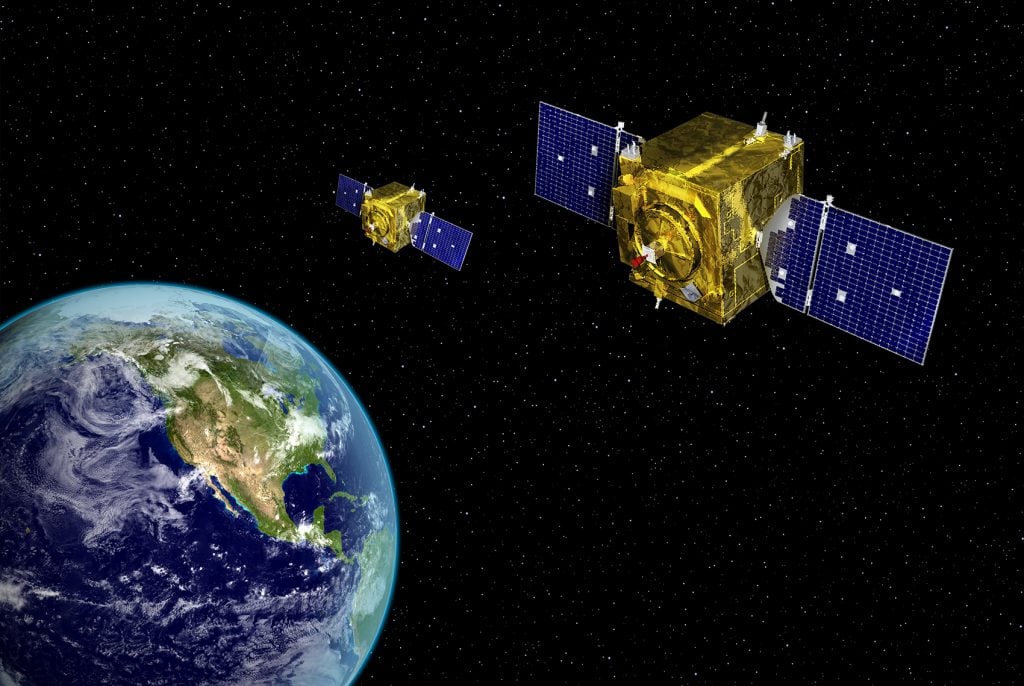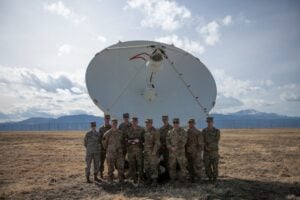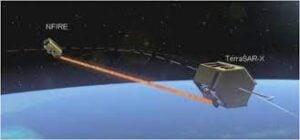THERESA HITCHENS

WASHINGTON: With Defense Department leaders pushing to declassify and demonstrate an existing US anti-satellite weapon — news first reported by Breaking Defense — the question becomes what kind of system might be revealed.
Considering that whatever the system is, it has long been covered by the deepest, darkest cloak of secrecy — i.e. under a so-called Special Access Program, or SAP — it is impossible to say for sure. As the old saying attributed to the Tao Te Ching goes: “Those who know do not speak. Those who speak do not know.”
But there are enough hints shared by sources and details scattered through the history of counterspace capabilities to provide an idea of what might be on the table. To that point, let the educated guessing — or, to be less generous, the rampant speculation — begin.
Origins
Some history on counterspace weapons is needed, because there is some reason to believe the program that could be unveiled shortly had its gestation in the administration of George W. Bush — or perhaps even as early as the Clinton administration.
The Clinton White House, in its 1996 National Space Policy, signed off on the use of anti-satellite weapons (ASATs), with the decision in the hands of the president. However, according to senior officials at the time, they ruled out the use of kinetic energy anti-satellite (KE-ASAT) weapons; favoring instead electronic warfare capabilities to avoid creating dangerous space junk.
The Bush administration’s 2006 policy prompted widespread US public and international criticism about its open embrace of space weapons, distain of international agreements and “unilateralist” tone. That same year, the then-commander of Strategic Command, Gen. James “Hoss” Cartright, commissioned an unclassified (but hard to locate in the public domain) study of US vulnerabilities and potential remedies that could be implemented within five years.
That study, called Global Talon and since obtained by Breaking Defense, posited cyberattacks to prevent “hostile targeting,” and was one of the first to discuss “active defenses” for satellites.
Of course, the Bush administration — at Cartwright’s urging — went on to demonstrate a KE-ASAT capability in 2008, with the Burnt Frost mission to shoot down the dysfunctional National Reconnaissance Office USA-193 satellite.
To be fair, the US military has experimented with ASATs, or in today’s lingo counterspace weapons, since the dawn of the Space Age. The litany of experiments and development programs is long, and one of the best primers on the state of current US capabilities is the Secure World Foundation’s annual report, “Global Counterspace Capabilities.”

The Counter Communications System.
However, there is only one declared counterspace weapon in the US inventory: the Counter Communications System (CCS), a mobile RF jammer that consistently has been upgraded over the past 20 years.
Bearing the past in mind and given the state of current technology, combined with discussions with a collection of scientists, experts and former government officials, concepts that could be on the table include:
Ground-based mobile laser
Bets are leaning heavily towards the new capability being based in space, not on the ground — precisely because the US has already demonstrated ground, sea and air-launched ASAT missile capabilities. Therefore, experts say, repeating a sat shoot down using a missile would be redundant, and lack the political oopmh of a display of military power in space.
Still, some say, one possibility might be a ground-based, mobile laser weapon designed to blind, or completely disable, enemy reconnaissance satellites in Low Earth Orbit (LEO, orbiting at below 2,000 kilometers in altitude.)
In 2002, the Bush administration announced the start of two offensive space capabilities: CCS and the Counter Surveillance Reconnaissance System (CSRS, pronounced scissors), which was abruptly cancelled in 2004. While DoD never revealed what the system actually entailed, the word on the street at the time was that it used a laser designed to blind satellite optical systems.
The saga of its mysterious demise was written about by Jeffrey Lewis, now with the James Martin Center for Nonproliferation Studies in Monterrey, Calif., in his Arms Control Wonk blog — a set of circumstances that led many to speculate that the program had not been killed but instead faded into the black world.
Space-Based Disabling Tech — RF Jammers, High Power Microwave Blasters, Lasers
By far the most popular guess was an on-board RF jammer — either carried by certain highly valuable US satellites themselves, or more likely on maneuverable “bodyguard” satellites. (Think of how fighter jets are used to defend high-valued aircraft, such as Air Force One.) The Air Force Research Laboratory (AFRL) in 2003 conducted one of its first tests of a maneuvering satellite, the XSS-10; XXS-11 was launched in 2005. And in 2014, the Air Force tested a similar satellite called the Automated Navigation and Guidance Experiment for Local Space (ANGELS) designed to conduct space situational awareness (SSA) tests.
In 2018, AFRL first tested the EAGLE system. Also ostensibly aimed at SSA, EAGLE deployed three small sats, one of which was called Mycroft after the older brother of fiction’s famous Sherlock Holmes. In 2019, Mycroft maneuvered closely around EAGLE as it aimed to characterize the nearby space environment, according to AFRL.
Today, there is GSSAP, for Geosynchronous Space Situational Awareness Program, an SSA constellation stationed in the most valuable real estate in space. Most of the world’s communications satellites, including US military ones carrying classified traffic, are in GEO.
The existence of GSSAP was declassified in 2014, but little is know about the satellites outside of their location in space. The Pentagon says that they provide a kind of space neighborhood watch — keeping tabs on dangerous space debris and looking out for threatening actions by other satellites, namely those of Russia and China. The satellites have conducted hundreds of maneuvers since 2014, including close approaches (known as proximity operations) of more than a dozen operational satellites in GEO, according to the SWF report.
On a technical basis, it would be fairly easy for GSSAP to also be carrying some kind of disabling tech that could be employed against enemy satellites. Perhaps the simplest option would be an RF jammer of some sort, that could overwhelm a target satellite’s ability to hear its own controllers and thus render it inert.
An on-board, low-power laser is another possibility, but that would take much more technical finesse given the physics involved with two bodies moving through space at high speeds. In addition, most advanced satellite optics have shutters to prevent them from being so overcome. With regard to disabling optics of any sort, a simpler solution might well be a kind of paint gun to spray them blind.
And of course high-powered lasers on-board a sat could be used to burn a hole in a target’s critical solar panel or elsewhere in what is known as a soft-kill (one that doesn’t break up the target), but there remain challenges to downsizing such lasers to fit on spacecraft.
Finally, there has been a lot of interest from DoD in high-power microwave weapons. A 1996 study, called An Operational Analysis for Air Force 2025: An Application of Value-Focused Thinking to Future Air and Space Capabilities, posited microsatellites carrying a miniature microwave weapon for blasting satellites or ballistic missiles in mid-flight through space.

NFIRE (Missile Defense Agency)
Space-Based Kinetic Kill — Children Of NFIRE?
Less likely, but not out of the realm of the possible, would be hunter-killer satellites using a kinetic kill vehicle, or perhaps themselves being used as kamikazes. There are political obstacles here, however, in that DoD has officially pledged to avoid creating long-lived space debris as one of Defense Secretary Lloyd Austin’s “tenets” for responsible behavior. That said, “long-lived” is understood within the US government to refer to space junk remaining on orbit in LEO for less than 25 years — which is the time it would take most things at very low orbits to fall into the atmosphere anyway.
Bush-era defense budgets including funding for a demonstration of a space-based kinetic KV, under the Near Field Infrared Experiment (NFIRE) program. NFIRE had the primary mission of characterizing ballistic missiles in mid-flight; however, the sensors were carried on a KV launched from the parent LEO satellite. The KV was killed later in the program, replaced by a laser communications system.
NFIRE, which was built by Orbital ATK (now Northrop Grumman Innovation Systems) wrapped up in 2015; but there isn’t any reason that the initial concept couldn’t have been carried into a top-secret program.
And Then There Is The X-37B
In February and again in May of 2020, the mysterious X-37B space plane was used to deploy several small satellites that were not officially cataloged by the United States, either in its own public database of satellites or in a (required by treaty) notice to the United Nations.
As the SWF paper put it: this “suggests that the X-37B may have a mission to serve as a covert satellite deployment platform. The secrecy surrounding both the X-37B and the deployment may indicate they are part of a covert intelligence program, but it may also indicate the testing of offensive technologies or capabilities.”
No comments:
Post a Comment